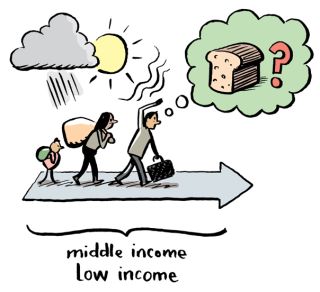A Blueprint for a Better Future?

Since the Russian invasion of Ukraine on the 24th February, an estimated 4.5 million people have fled Ukraine seeking refuge across international borders. The UNHCR has declared the situation a Level 3 Emergency, the most severe level used by the organisation.
International support for Ukraine during the emergency has been significant, particularly within Europe and the EU bloc. Many countries have pledged support in various methods, including access to cash for those staying in Poland, the waiving of usual visa restrictions for people fleeing the conflict and the activation of a Temporary Protection Directive by the EU - allowing access to social welfare, job markets and other social protections without the usual asylum processes.
In Ireland, the response has been similar, with Ukrainian refugees being welcomed, the provision of housing assistance on arrival and the allocation of a Personal Public Service Number (PPSN) without the usual lengthy processing time, allowing access to social welfare. Additionally, the Irish government has assigned €20 million in humanitarian aid to the crisis.
The international outpouring of support for Ukraine has been swift, vocal and highly efficient. International organisations, governments, NGOs and members of the public have welcomed not only humanitarian aid and financial support, but the provision of refuge with additional rights to victims of the conflict, during a time when there is more access than ever to information regarding the situation.
While this response to the Russian invasion of Ukraine is welcomed and a positive sign for the capabilities of a modern global community, the difference in response to a large-scale European migration event, when contrasted with that of migration events we have seen from further afield must be recognised.
The creation of special processes for those fleeing Ukraine highlight what could be done during other conflicts and mass-migration events worldwide. The money can be made available, the administrative side of things can be covered and the services can be provided. We see a clear distinction between the response to the current situation when compared to non-European events requiring international aid.
During the Syrian Refugee ‘Crisis’ of 2015, many European states spent time negotiating down the number of migrants they were expected to receive, citing issues such as strains on state resources, and in some cases, anti-refugee sentiment. Many citizens in European states also expressed concern about the implications of receiving high numbers of people fleeing from conflict in their own countries, such as the pressure it would place on welfare services, healthcare and accommodation. Many of the concerns raised in 2015 have been swiftly addressed through the response to the situation in Ukraine, with money being raised, accommodation made available and the activation of the EU-wide Temporary Protection Directive.
The UNHCR estimates that over 6.6 million people have been forced to migrate out of Syria since 2011. When one looks at the number of Ukrainians forced to flea in the first two months alone, and that 1 million Syrian migrants were provided with refuge in Europe, the disparities in responses by numbers alone are self-evident.
In the Irish context, the calls for an end to Direct Provision have been getting louder in recent years. Members of the public, NGOs and other organisations have been calling on the government to do something about the appalling conditions in which those in Direct Provision have been forced to live. In February of 2021, the Irish Government released the White Paper on Ending Direct Provision. The plan for a new “applicant-centred” system for those seeking refuge in the country was outlined, with a goal of 2024 for the new system to be fully underway.
Under the current system, those in Direct Provision are not initially provided with a PPSN. Their financial support amounts to €38.50 a week for adults, and €29.80 a week for children, once their application has been processed, for some this has meant a length wait-time, without income and without the ability to enrol their children in education. For those arriving from Ukraine, the welfare rate is €117.70 a week for those aged between 18 and 24, and moves up to €206 a week for those over 25. The immediate granting of PPSNs also allows for children to be enrolled in education without great delay. The clear disparity in supports is not one which means Irelands should do less for Ukrainians, but one which highlights just how immediately it is possible to change how Ireland can support not only migrants and refugees from everywhere else in the world, but also those living in Ireland who are at the peripheries of state support.
Ireland’s healthcare system is already under strain, with even more pressure placed on the underserved sector due to the COVID-19 Pandemic. With Ireland’s swift response to welcoming migrants from Ukraine, those arriving, who have been allocated medical cards, with undoubtedly require medical care, whether this be mental health services or physical ones. This influx of people to cater for and the special provisions granted to them highlight the capabilities of the Irish government to make allowances and increase the number of people who receive support from our public sector. While the health services need additional resources and increased accessibility, so too do those in society who are underserved by the current system.
The recent changes to who can access care, whether it be healthcare, education, financial social welfare supports or accommodation highlight a more optimistic outcome from government policy if it is chosen. The two-tier system for refugees and asylum seekers in Ireland, while pointing to an undoubtedly unfair and unequal treatment of refugees in the state, also highlights the potential for change is not as out of reach as was once thought in Ireland. Much like the change in perception of the social welfare system due to COVID-19, this situation once again reveals the potential which may be harnessed from emergency action, and the way in which it stands to improve inequalities in society without great waiting times.